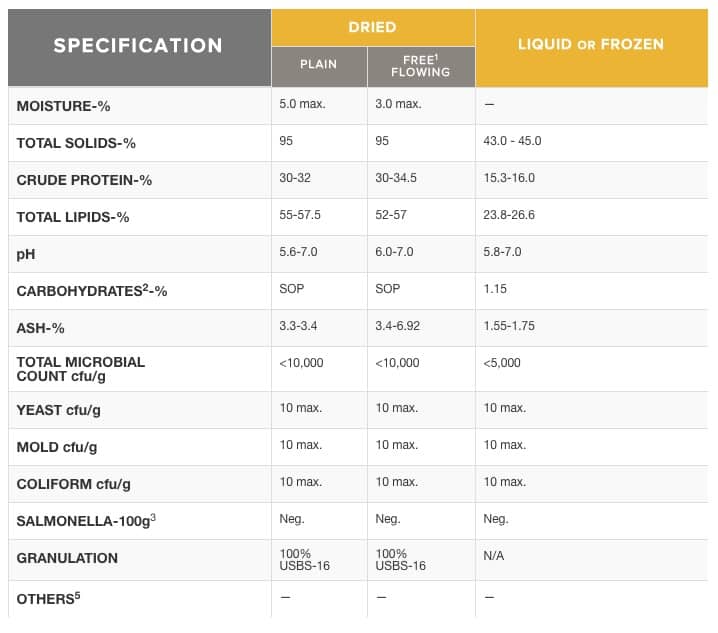Egg Yolk Types
DRIED EGG YOLK
Egg yolk, or the yellow, comprises 30 to 33 percent of the total liquid weight of a whole egg and contains the entire fat content, along with a little less than half the protein and a high proportion of vitamins and minerals. Interestingly, egg yolk is one of the few foods to naturally contain vitamin D.
When dried, most of the moisture is removed from egg yolks, providing food formulators with a highly concentrated source of egg lipids including triglycerides, phospholipids, cholesterol, cerbroside and other minor lipids. Product developers are relieved to know that eggs contain no trans fatty acids. Indeed, many product developers seek out egg yolks because of the fats they do contain, in particular, the phospholipid lecithin, which acts as an emulsifying agent in foods. Phospholipids can also be used to coat ingredients, aiding in their dispersion in a food matrix.
Dried egg yolks are typically spray-dried. Sucrose, corn syrup or sodium silicoaluminate are sometimes added as anti-caking agents to assure a free-flowing product. Without the ingredients, the dried egg yolk could harden and solidify, making it difficult to incorporate into food systems.
Indeed, egg yolks are best known for their emulsification properties, particularly in mayonnaise, salad dressing and creamy sauces, but they have other applications, too. For example, dried egg yolks are commonly used in bakery mixes. When prepared, the baked product has a rich color that comes from the carotenoids present in the lipid portion of the yolk. Also in baked products, the lecithin in the yolk reduces the rate of moisture loss, in fact, the yolk exerts a tenderizing effect. When combined with other ingredients such as cream or milk, egg yolk creates the perfect glaze for sealing breads, rolls and pocket-style sandwiches. The glaze helps prevent the crust from drying out and becoming tough, as well as provides a shiny golden-brown surface.
REFRIGERATED LIQUID/FROZEN EGG YOLK
Egg yolk products come in a variety of forms, with liquid being one of the most commonly used by food formulators. Liquid egg yolk products are sold refrigerated and are always pasteurized for safety and shelf life. Liquid egg yolk products can also include other ingredients such as salt or sugar for added shelf life and enhanced functionality.
Egg yolks are best known for their emulsification properties, particularly in mayonnaise, salad dressing and cream‐style sauces. They have many other functional properties, too. For example, in bakery products, yolks impart a rich color that comes from the carotenoids present in the lipid portion of the yolk. The lecithin in the yolk also reduces the rate of moisture loss, at the same time it exerts a tenderizing effect on the crumb.
Egg yolks are also used to impart richness to ice cream and frozen custard.
AVAILABILITY
DRIED EGG YOLK
- Egg Yolk Solids
- Enzyme Modified Egg Yolk Solids
- Free-Flowing Egg Yolk Solids (with free-flow agent added)
REFRIGERATED LIQUID/FROZEN EGG YOLK
- Egg Yolk
- Enzyme Modified Egg Yolk
- Extended shelf Life Egg Yolk
- Salted Egg Yolk
- Sugared Egg Yolk
PRODUCT CONVERSION
Use this chart to convert refrigerated/frozen egg products to shell or dried egg products.

Egg Yolk Specifications

References
- Free-flowing products contain less than 2% sodium silicoaluminate.
- Most dried egg whites are desugared. Whole egg and yolk products are desugared if specified on purchase (SOP).
- Negative by USDA approved testing procedures.
- U.S. Bureau of Standards.
- Additives and performance specifications may be specified on purchase.
